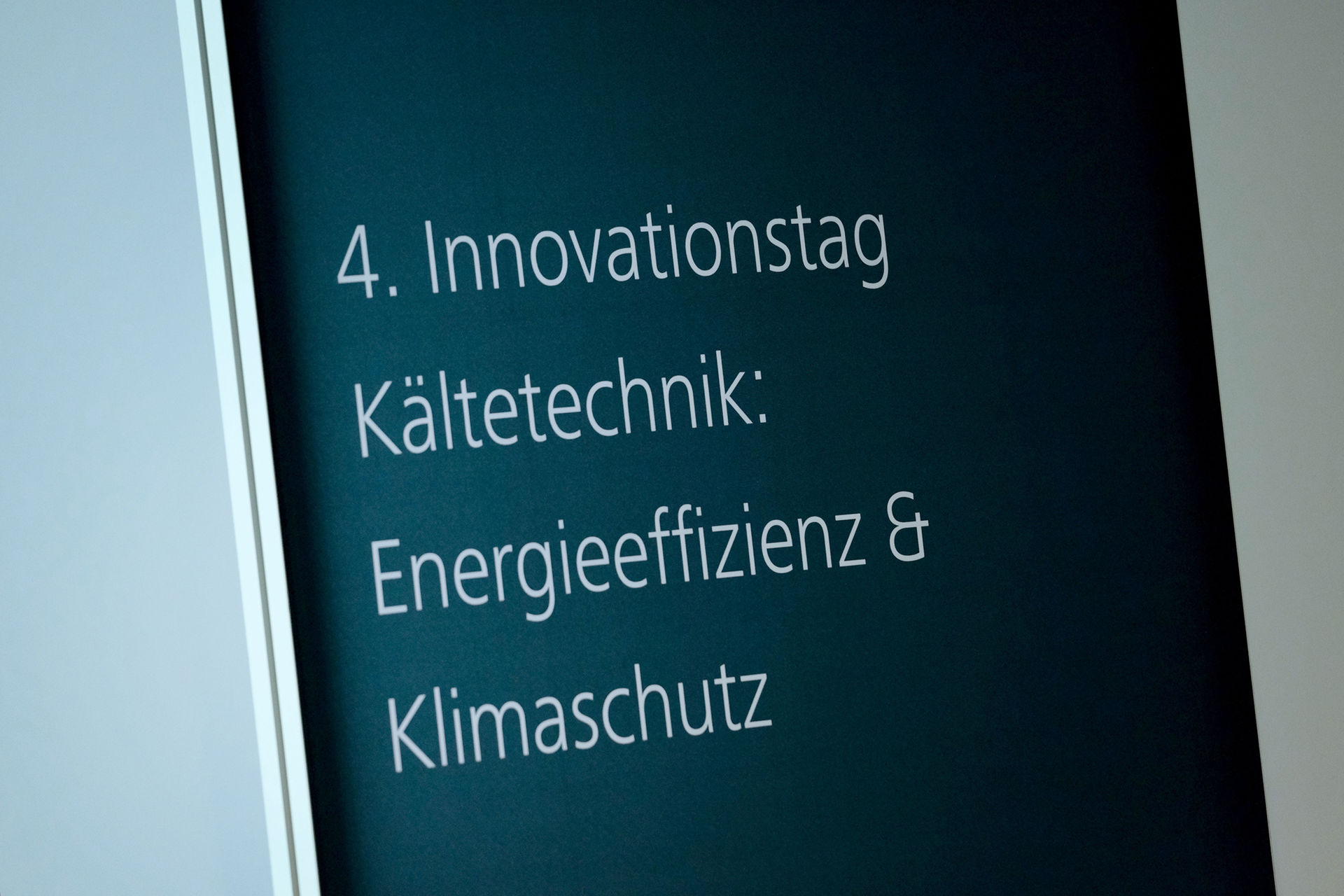European Heat Pump Summit Newsroom
Caloric systems: solid-state cooling and heating

The Caloric Workshop 2017 was held for the first time in late March at the Fraunhofer Institute for Physical Measurement Techniques (Fraunhofer IPM), and was arranged by the Institute in collaboration with the German Society of Refrigeration and Air Conditioning (DKV). The event focused on solid-state cooling and heating. Around 80 participants from the worlds of science, development and industry gathered for a fascinating one-day event comprising seven presentations. Acknowledged experts provided an overview of current developments and trends in magnetocaloric, electrocaloric and elastocaloric systems. Magnetocaloric systems made up the largest proportion of those covered by the workshop. To show how they work, Fraunhofer IPM displayed a number of operating magnetocaloric and elastocaloric demonstrator units from their research projects. See also Back-up III.
The trend toward making cooling, heating and air-conditioning available as efficiently and sustainably as possible will play a major part in shaping developments in the years to come, particularly in the context of the changing energy landscape. In the case of cooling technology, stringent demands for energy-efficient and environmentally friendly solutions are driving the search for new technologies in line with technical/economic and environmental objectives.
At a global level, these must incorporate criteria like the changing energy supply structure and the increasing use of renewables in the best way possible, and make the fullest possible use of them. Pressure is on the refrigeration, air-conditioning and heat pump sector not only to make suitable products available, but also to develop operator models, for example, that can cope with the complicated tasks that have developed over time.
Which refrigeration and heat pump processes are currently available?
A distinction is made between processes that use materials and those that consume energy; see also Back-up I.
Processes using materials
Ice and snow
Cooling technology was first developed to keep foodstuffs cool, drinks in particular, since natural sources of refrigeration were not available everywhere and in sufficient quantity at all times. In ancient times, snow and ice were gathered during the winter and stored in caves or in artificially insulated cellars until summer. The main purpose appears to have been more to keep drinks cool rather than foodstuffs. In ancient China, religious ceremonies accompanied the filling and emptying of the ice cellars. Athenaeus wrote that, during his Persian campaigns (330 BC), Alexander the Great had 30 trenches dug and filled with snow, to keep wine cool for his soldiers during the siege of Petra. The Romans gathered snow and ice from the Alps, which when mixed with drinks not infrequently resulted in illness. Pliny reported that Emperor Nero had his drinking water boiled and the containers then covered with snow. And in Pompeii, remains have been found of drinks counters that were cooled with ice or snow. In areas where no snow could be found at any time of the year, a number of processes were used even in ancient times to provide artificial refrigeration.
Evaporation cooling
In Egypt, where ice never occurs naturally, the first records of deliberate cooling may be found on ancient frescoes (2,500 BC) that show slaves fanning large clay jars to cool the drinking water through evaporation. Greek sophist Protagoras visited the Nile plain in the 5th century BC and reported that the local inhabitants placed clay pots, filled with water and moistened on the outside, on the roofs of their houses to expose them to the cool, dry night air. Evaporation chill and heat emission cooled the water, which even occasionally became coated with a layer of ice on clear nights. A similar procedure is known from India, where flat clay vessels full of water were arranged on dry straw mats overnight.
Cooling mixtures
The use of cooling mixtures was known in ancient times, as may be concluded from the Indian book “Pancatantram” (4th century AD), which states, “Water is cool when it contains salt.” This process seems to have reached Europe from Asia in the 15th and 16th centuries. Cooling water by dissolving saltpetre is described by Monardus (1493-1578), the Apulian physician Zimara (professor at Padua from 1525 to 1532) and Spanish physician Villafranca in 1550. The next step on the path to lower temperatures was achieved by mixing saltpetre with snow, first mentioned by Baptista Porta in Naples in 1589. Fahrenheit used a method of lowering temperature using snow and salammoniac to determine the zero point in his temperature scale.
[Plank, R., Hdb. der Kältetechnik (Manual of Refrigeration), Vol. I, pp. 1-5, Springer Verlag 1954]
Processes involving energy input
Among processes involving energy input, a distinction is made between vapour cooling and cold gas processes on the one hand, and solid-state processes on the other.
Vapour cooling processes
Vapour cooling processes include the traditional process using mechanical compression, which predominates in refrigeration and heat pump applications. Thermal compression involves sorption processes, which are divided into absorption and adsorption processes. Thermal compression is often found in cases where high-temperature waste heat is available. Vapour cooling processes use substances that liquefy and/or evaporate during the process. The birth of the modern vapour compression refrigeration system can be dated to 1834, when Jacob Perkins, an American who had emigrated to the UK, registered his famous British patent no. 6662, “apparatus for producing cold and cooling fluids”. Ferdinand Carré recognised that a more volatile cooling agent was required for refrigeration to be economical. He decided to make use of the high solubility of ammonia in water, and on 24 August 1859 registered his seminal patent for an absorption refrigerator using ammonia. Water, which had previously been used as the refrigerant, served as the absorbent in this case, and ammonia was used as the refrigerant for the first time. Carré constructed two types of absorption machine using ammonia as the refrigerant, one operating periodically for minor tasks and one continuously for larger tasks.
Cold gas processes
The first air-based cooling machine was constructed in 1844 by American doctor John Gorrie to generate ice for patient treatment. Subsequent improvements were made by William J.M. Rankine, Carl Wilhelm Siemens and James Watt, while Scottish engineer Alexander Carnegie Kirk developed the first air-cooling system suitable for industrial use (1862). Since 1944, air-cooling devices have been used in aeroplanes for air-conditioning and refrigeration. Cold gas processes use substances that do not liquefy or evaporate, but always stay in a gaseous state.
Solid-state processes
Solid-state cooling systems based on caloric materials are a future-oriented alternative to compressor-based cooling technology. A number of magnetocaloric refrigeration systems have been produced in recent years. Elastocaloric and electrocaloric materials can also be used to create cooling systems and heat pumps that do not require refrigerants, and may potentially be superior to traditional refrigeration systems in terms of energy efficiency. Caloric materials exert a powerful, reversible heating reaction when an appropriate field is applied (electrical or magnetic field or mechanical force) and cool down again when the field is removed. The temperature in this case falls to below the starting temperature. This effect can be used to create a cooling cycle: the heated material is connected to a heat sink to draw off the heat that is generated. If it is connected to a point that requires cooling, it will take up heat until it reaches its starting temperature again. This creates a cooling cycle with no need for refrigerants.
Among the solid-state processes, a distinction is made between thermoelectric, thermomagnetic and thermoelastic processes.
Thermoelectric process
In about 1821, Seebeck discovered that a thermoelectric force that generates a current is created in an electrical circuit consisting of two different conductors whose junctions are kept at different temperatures. In 1834, Peltier discovered the reverse effect: if a current is directed through a non-homogeneous conductor circuit, the junctions will either cool or heat, depending on the direction of the current. Heat is taken up from the environment at one junction, and is released to the environment at the other. Edmund Altenkirch was the first to consider a practical application of the Peltier effect for refrigeration and perform the calculations for a corresponding system (1911).
[Plank, R., Hdb. der Kältetechnik (Manual of Refrigeration), Vol. III, pp. 52-77, Springer Verlag 1959]
Practical application of these systems began in the 1960s. “Peltier cooling” can now be found in small cool boxes, for example, for keeping milk cool next to a coffee dispenser, or to ensure the accurate cooling of elements in electronics.
Thermomagnetic process
The discovery of the magnetocaloric effect dates back to Warburg in 1881. Later, in about 1926, Debye and Giauque continued this work independently of each other. The goal at the time was always to achieve the lowest possible temperatures close to absolute zero [Mendelssohn, K., The Quest for Absolute Zero, Weidenfeld & Nicolson 1966]. From the outset, the magnetocaloric effect has been put to practical use mainly in cryotechnology, to achieve extremely low temperatures in place of other, more labour-intensive refrigeration processes, e.g. 3He/4He dilution refrigeration. Magnetocaloric cooling at temperatures close to room temperature has made a huge leap in development in recent decades, with great advances in performance. The focus of current research activities is on domestic refrigerators and freezers, and devices in the lower power ranges used in industrial and commercial refrigeration. Even if published theoretical calculations provide grounds for optimism, the practical proof that magnetocaloric refrigeration devices or heat pumps can surpass conventional methods of refrigeration in terms of efficiency and cost-efficiency in particular applications is still pending. See also [Langebach, R., Klaus, M., Haberstroh, C., Hesse, U.: Magnetokalorische Kälteerzeugung – Eine Option für Haushaltskühlgeräte? (Magnetocaloric Cooling – an Option for Domestic Refrigerators?), AA II.1, DKV Congress 2013, Hanover].
Thermoelastic process
Elastocaloric materials are known from other applications as “shape-memory alloys”. A change of shape can be induced in these alloys by the application of heat. The reverse effect can also be used: applying force to the material generates reversible heat. In the same way as magnetocalorics or electrocalorics, this can be used to construct a cooling system with the appropriate system integration. German research society DFG is running a major project in this area: www.ferroiccooling.de
Back-up I contains an overview of the cooling and heat pump processes.
Back-up II contains more on the various caloric systems.
Back-up III contains a short report on the Caloric Workshop in Freiburg.
